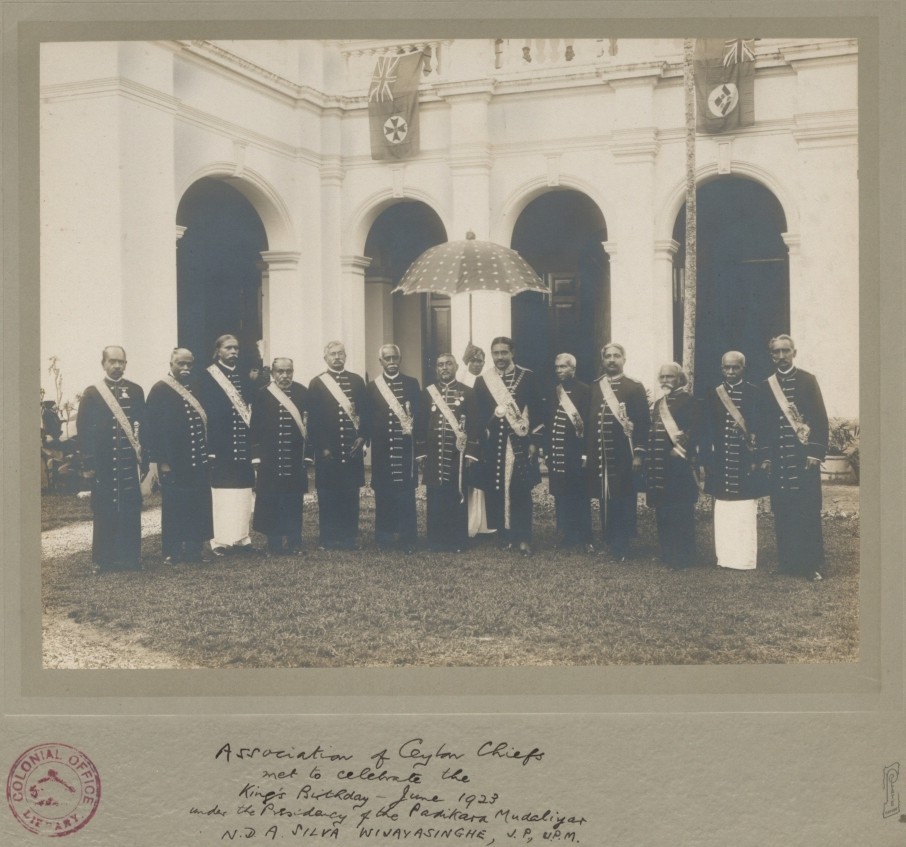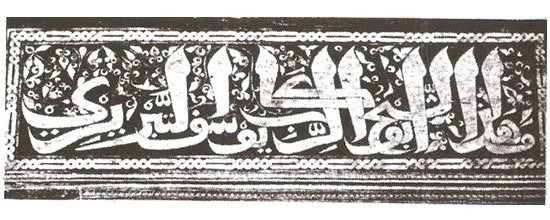|
Maldivian Annual Tribute
The Maldivian Annual Tribute was a tribute presented each year by the Sultan of the Maldives to the British Governor of Ceylon. The tributes were presented after the Maldive islands became a British protectorate in 1887 and were carried out annually until 1947 when a new agreement removed the requirement of tributes, however Maldives remained a British protectorate until 1953 when the sultanate was suspended and the First Republic was declared. Ceremony The presentation of tributes took place in November, with the Sultan's state schooner carrying the gifts arriving in Colombo at the end of the monsoon season. An afternoon was fixed and the Maldivian Representative in Colombo boarded the schooner and returned with several ''divahin'' carrying the gifts on their heads. The Maldivian party was met at the harbor jetty by Ceylonese Mudaliyars in uniform and a Lascarins guard of honour and band, as well as a police detachment to escort the Maldivian party to the Queen's House on foot. The ... [...More Info...] [...Related Items...] OR: [Wikipedia] [Google] [Baidu] |
Tribute
A tribute (; from Latin ''tributum'', "contribution") is wealth, often in kind, that a party gives to another as a sign of submission, allegiance or respect. Various ancient states exacted tribute from the rulers of land which the state conquered or otherwise threatened to conquer. In case of alliances, lesser parties may pay tribute to more powerful parties as a sign of allegiance and often in order to finance projects that would benefit both parties. To be called "tribute" a recognition by the payer of political submission to the payee is normally required; the large sums, essentially protection money, paid by the later Roman and Byzantine Empires to barbarian peoples to prevent them attacking imperial territory, would not usually be termed "tribute" as the Empire accepted no inferior political position. Payments ''by'' a superior political entity to an inferior one, made for various purposes, are described by terms including " subsidy". The ancient Persian Achaemenid Empir ... [...More Info...] [...Related Items...] OR: [Wikipedia] [Google] [Baidu] |
Maldives Sultanate
Maldives was turned into a Sultanate in 1153 when the Buddhist King Dhovemi converted to Islam. Prior to that the Maldives was a Buddhist Kingdom, a Hindu Kingdom and before that a matriarchal society with each atoll ruled by a chief queen according to some accounts or by others, several theocratic societies ruled by priests known as ''Sawamias'' of heliolatric, selenolatric and astrolatric religions. All the rulers before King Koimala only ruled over parts of the Maldives or Deeva Maari (and Dheeva Mahal) as it was known then. Koimala was the first king to rule over all the islands of the Maldives as we know today and the island of Maliku. The formal title of the Sultan up to 1965 was, ''Sultan of Land and Sea, Lord of the twelve-thousand islands and Sultan of the Maldives'' which came with the style ''Highness''. After independence in 1965 the Sultan assumed the title King with the style Majesty. This style was used until 1968, when the Maldives became a republic for th ... [...More Info...] [...Related Items...] OR: [Wikipedia] [Google] [Baidu] |
British Governor Of Ceylon
The governor of Ceylon was the representative in Ceylon of the British Crown from 1795 to 1948. In this capacity, the governor was president of the Executive Council and Commander-in-Chief of the British Forces in Ceylon. The governor was the head of the British colonial administration in Ceylon, reporting to the Colonial Office. With Ceylon gaining self-rule and dominion status with the creation of Dominion of Ceylon in 1948, this office was replaced by the Governor-General, who represented the British monarch as the head of state. The office of Governor-General was itself abolished in 1972 and replaced by the post of President when Sri Lanka became a republic. Appointment The governor, appointed by the British monarch (on the advice of the prime minister and the secretary of state for the colonies), maintained executive power in Ceylon throughout British rule. Powers and functions The governor was the head of the executive administration in the island. Initially limit ... [...More Info...] [...Related Items...] OR: [Wikipedia] [Google] [Baidu] |
Ceylonese Mudaliyars
Mudali (or Mudaliyar) was a colonial title and office in Ceylon (now Sri Lanka) which was part of the native headman system. The Portuguese colonials created the Mudaliyar class in the 17th century by enlisting natives of different castes from the coastal areas. The Dutch continued the practice of the Portuguese. This class used the ''Mudali'' as a hereditary title, however the British re-established a Mudaliyar class, with appointments that had the title of Mudali, this process was stopped in the 1930s when the Native Department of the British government of Ceylon was closed down. All official and titular appointments of Mudaliyars were made by the Governor of Ceylon. Appointments were non-transferable and usually hereditary, made to locals from wealthy influential families loyal to the British Crown. The members of this group formed a unique social group called the Sri Lankan Mudaliyars and associated with older Radala caste. At present, the post of Court Mudliar remain in ... [...More Info...] [...Related Items...] OR: [Wikipedia] [Google] [Baidu] |
Lascarins
Lascarins ( si, ලස්කිරිඤ්ඤ, translit=laskiriñña'','' or Lascareen, Lascoreen and Lascarine) is a term used in Sri Lanka to identify indigenous soldiers who fought for the Portuguese during the Portuguese era (1505–1658) and continued to serve as colonial soldiers until the 1930s. The lascarins played a crucial role not only in the colonial armies, but also in the success of the campaigns of the local kingdoms.The Portuguese in Ceylon: Before the war with the Dutch - Colonial Voyage Web. Accessed 2015-11-25 [...More Info...] [...Related Items...] OR: [Wikipedia] [Google] [Baidu] |
Queen's House, Colombo
President's House is the official residence and workplace of the President of Sri Lanka, located at Janadhipathi Mawatha, Colombo, Sri Lanka. Since 1804 it had been the residence of British Governors and Governors-General and was known as the "King's House" or the "Queen's House" until Sri Lanka became a republic in 1972. There were 29 Governors who resided here, and there have also been six Presidents who have resided or used it in an official capacity. It was most recently used by Gotabaya Rajapaksa, the President of Sri Lanka for state functions until anti-government protestors stormed the compound and occupied it. The Presidential Secretariat functions as the Office of the President, with much of the presidential staff based there. History Dutch period The last Dutch Governor, Johan van Angelbeek, built a two-storied residence on the site of the demolished St Francis's Church, which had been built by the Portuguese in the 16th century. British period It was sold to ... [...More Info...] [...Related Items...] OR: [Wikipedia] [Google] [Baidu] |
Maldivian Language
Maldivian, also known by its endonym Dhivehi or Divehi ( ; '' dv, links=no, ދިވެހި'', ), is an Indo-Aryan language spoken in the South Asian island country of Maldives and on Minicoy Island, Lakshadweep, union territory of India. The Maldivian language has notable dialects. The standard dialect is that of the capital city, Malé. The greatest dialectal variation is from the southern atolls Huvadu, Addu and Fuvahmulah of Maldives. Each of those atolls has its own dialect closely related to each other but very different from the northern atolls. The southern atoll dialects are so distinct that those only speaking northern dialects cannot understand them. The ethnic endonym for the language, ''Divehi'', is occasionally found in English as ''Dhivehi'' (spelled according to the locally used Malé Latin for romanisation of the Maldivian language), which is the official spelling as well as the common usage in the Maldives. Dhivehi is written in Thaana script. Dhivehi is a ... [...More Info...] [...Related Items...] OR: [Wikipedia] [Google] [Baidu] |
Lacquer
Lacquer is a type of hard and usually shiny coating or finish applied to materials such as wood or metal. It is most often made from resin extracted from trees and waxes and has been in use since antiquity. Asian lacquerware, which may be called "true lacquer", are objects coated with the treated, dyed and dried sap of ''Toxicodendron vernicifluum'' or related trees, applied in several coats to a base that is usually wood. This dries to a very hard and smooth surface layer which is durable, waterproof, and attractive in feel and look. Asian lacquer is sometimes painted with pictures, inlaid with shell and other materials, or carved, as well as dusted with gold and given other further decorative treatments. In modern techniques, lacquer means a range of clear or pigmented coatings that dry by solvent evaporation to produce a hard, durable finish. The finish can be of any sheen level from ultra matte to high gloss, and it can be further polished as required. Lacquer finishes ... [...More Info...] [...Related Items...] OR: [Wikipedia] [Google] [Baidu] |
Sweetmeat
Confectionery is the art of making confections, which are food items that are rich in sugar and carbohydrates. Exact definitions are difficult. In general, however, confectionery is divided into two broad and somewhat overlapping categories: bakers' confections and sugar confections. The occupation of confectioner encompasses the categories of cooking performed by both the French ''patissier'' (pastry chef) and the ''confiseur'' (sugar worker). Bakers' confectionery, also called flour confections, includes principally sweet pastries, cakes, and similar baked goods. Baker's confectionery excludes everyday breads, and thus is a subset of products produced by a baker. Sugar confectionery includes candies (also called ''sweets'', short for ''sweetmeats'', in many English-speaking countries), candied nuts, chocolates, chewing gum, bubble gum, pastillage, and other confections that are made primarily of sugar. In some cases, chocolate confections (confections made of chocolate) ... [...More Info...] [...Related Items...] OR: [Wikipedia] [Google] [Baidu] |
Ambergris
Ambergris ( or , la, ambra grisea, fro, ambre gris), ''ambergrease'', or grey amber is a solid, waxy, flammable substance of a dull grey or blackish colour produced in the digestive system of sperm whales. Freshly produced ambergris has a marine, fecal odor. It acquires a sweet, earthy scent as it ages, commonly likened to the fragrance of Isopropyl alcohol without the vaporous chemical astringency. Ambergris has been highly valued by perfume makers as a fixative that allows the scent to endure much longer, although it has been mostly replaced by synthetic ambroxide. Dogs are attracted to the smell of ambergris and are sometimes used by ambergris searchers. Etymology The word ''ambergris'' comes from the Old French "''ambre gris''" or "grey amber". The word "amber" comes from the same source, but it has been applied almost exclusively to fossilized tree resins from the Baltic region since the late 13th century in Europe. Furthermore, the word "amber" is derived from the Mid ... [...More Info...] [...Related Items...] OR: [Wikipedia] [Google] [Baidu] |
History Of The Maldives
The history of the Maldives is intertwined with the history of the broader Indian subcontinent and the surrounding regions, comprising the areas of South Asia and Indian Ocean; and the modern nation consisting of 26 natural atolls, comprising 1194 islands. Historically, the Maldives had a strategic importance because of its location on the major marine routes of the Indian Ocean.. The Maldives' nearest neighbours are the British Indian Ocean Territory, Sri Lanka and India. The United Kingdom, Sri Lanka and some Indian kingdoms have had cultural and economic ties with the Maldives for centuries. In addition to these countries, Maldivians also traded with Aceh and many other kingdoms in, what is today, Indonesia and Malaysia. The Maldives provided the main source of cowrie shells, then used as a currency throughout Asia and parts of the East African coast. Most probably Maldives were influenced by Kalingas of ancient India who were earliest sea traders to Sri Lanka and the Maldives ... [...More Info...] [...Related Items...] OR: [Wikipedia] [Google] [Baidu] |



.jpg)
_170.jpg)



